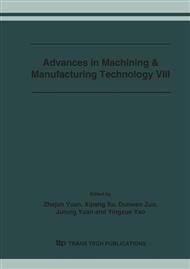p.661
p.666
p.671
p.676
p.681
p.686
p.691
p.696
p.701
Deducing the Coefficient of Non-Free Cutting of Major Cutting Edges of a Standard Twist Drill
Abstract:
A standard twist drill is divided into a series of elementary cutting tools (ECT) along its major cutting edges. The natural power consumed by each ECT during free cutting is calculated on the basis of the theory of shear plane. Through optimization, the actual power consumed and the coefficient of non-free cutting of the major cutting edges subject to the principle of minimum energy are calculated. The results indicate that although the major cutting edges of the standard twist drill are straight lines, their cutting process is not free cutting in full sense of the term.
Info:
Periodical:
Pages:
681-685
Citation:
Online since:
July 2006
Authors:
Price:
Сopyright:
© 2006 Trans Tech Publications Ltd. All Rights Reserved
Share:
Citation:


